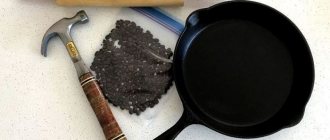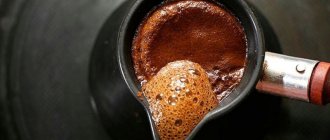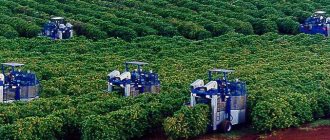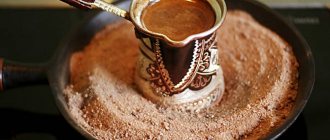A cup of invigorating, aromatic grain coffee - few people can refuse such pleasure. Coffee has long been one of the most popular tonic drinks all over the world, and most gourmets prefer a natural drink, and to obtain a truly tasty drink you need raw materials suitable for its preparation - coffee beans.
Nowadays, getting grains is not a problem; they are sold in almost every grocery store, but many, purchasing goods on sale or in large containers for a long period, are wondering how to properly store the product at home so that the prepared drink does not lose quality. There is a lot of advice on this matter, so let’s try, by collecting and analyzing information from professionals, to answer the most popular questions of lovers of natural coffee prepared with our own hands.
Types of storage – long-term and short-term
Short-term and long-term storage of a product require completely different conditions. The need to preserve taste and aroma for a long period of time appears only when purchased for future use. For example, if you were able to purchase several packages at a promotion or you placed an order abroad. If there is no special need, you should not buy for future use; it is better to buy it for 1-2 weeks. In this case, you can enjoy a fresh, aromatic drink every time. Please note that almost immediately after roasting, coffee begins to fade, and the ground powder quickly becomes unusable.
- Don't miss: How to Roast Coffee Beans at Home
Adviсe
Preparing an aromatic drink from ground coffee beans also has its secrets. The main rule when preparing coffee in a Turk or by brewing in a coffee pot is to use suitable water in the recipe. For cooking, it is better to use bottled or filtered liquid - such water is softer, so it will reveal more of the aroma. Coffee lovers also recommend following a number of standards:
- It is better to choose brown sugar for the drink - it will only emphasize the taste of the drink. A separate advantage of this choice is the reduced calorie content.
- When adding spices during the coffee brewing process, it is recommended to add a small pinch of salt. This mineral will extinguish excess bitterness if the amount of cinnamon or pepper is exceeded.
- The drink must be prepared in small, strictly dosed quantities, since over time, brewed coffee loses its aroma and taste. You can fully enjoy its qualities for about 1 hour.
For reference!
It is better to grind the grains immediately before preparing the drink, instead of storing them for a long time.
To reveal the aroma when brewing coffee according to the norms, the ground beans must be added first, and then filled with cold water. If sugar is added to the drink, then it is correct to add it to the cezve, along with the powder - this way the aroma and foam on the surface of the cup will be preserved to the utmost. You need to adjust the strength of the drink by the duration of cooking on the stove, and not by the amount of ground grain.
Period and storage conditions of coffee beans
How long coffee can be stored depends directly on the packaging:
- loose grains sold in a paper bag – 2 weeks;
- in sealed four-layer paper bags – six months;
- in the same bags with additional coating with polymer film – 9 months;
- Shelf life of roasted coffee beans in packaging with an air valve is 1 year;
- in a factory opaque jar - 1.5 years;
- in a vacuum pack – 1.5 years.
Coffee shelf life after opening the package lasts 12-14 days. The optimal storage temperature is room temperature, about 25 degrees.
An incorrectly selected container for grains can result in a rapid loss of taste. Therefore, if you want to extend their shelf life, you need to approach the choice of container with all responsibility:
- foil bags They reliably protect from odors, moisture, light and do not allow air to pass through. Due to the valve, gases escape from fresh grains. Also, such a bag can be twisted to remove excess air - this minimizes the oxidation of essential oils responsible for the taste and aroma during the shelf life of coffee.
- Glass and ceramic jars with lids with a silicone gasket to seal tightly will prevent air from getting inside. Also, in such containers the contents are protected from moisture and odors. In this case, the glass jar should either be opaque, or it should be stored in the dark. Just keep in mind that it is better to pour the beans into the jar a couple of days after roasting so that the gases escape. And oxidation inside will continue.
- Tin cans are light and compact, but the product may have a metallic taste.
- Plastic containers are an extremely bad option. There may be a specific smell, and the moisture protection is weak due to the lack of a sealed lid, so the coffee may spoil before the expiration date.
- Wooden boxes and caskets are suitable only for the role of decorative elements. They do not protect against moisture, odors, and after 5-6 days oxidation begins, and if the product is ground, then even earlier.
To prolong the shelf life of the grains, they should be stored in a closed cabinet. There they will be in darkness and a constant level of humidity, without drafts. Ideally, the cabinet should be located away from the stove, sink, and strong-smelling spices.
Unroasted grains
You can of course drink expired coffee. But it’s better not to let it come to that.
It is much easier to purchase green grains. There are several objective reasons for this.
- Much lower price compared to fried. You can compare the rating of bean coffee.
- Can be stored for up to 5 years. Taste and aromatic properties are fully preserved for up to a year.
An important point is packaging. Sealed and vacuum containers ensure a longer shelf life.
If products are purchased by weight, and it is not possible to read the information about the expiration date on the packaging, you need to pay attention to the appearance of the grain. You need to focus on the following rules.
- Fresh grains have the same color and pleasant aroma. The structure is smooth, without chips.
- If the grains have different colors and sizes, then it is probably a mixture of different harvests. As a rule, such a blend will contain old grains, possibly already expired.
- The absence of odor indicates that it is already old grain.
Can it be stored in the refrigerator?
Many people advise storing coffee in the refrigerator - supposedly the esters do not erode at subzero temperatures. In fact, due to their dense structure, oils do not evaporate anyway. Only the aroma disappears. The problem is not cold, but oxidation, so it is important to avoid contact with oxygen throughout the coffee's shelf life. It is not recommended to keep the product in the refrigerator compartment - it is humid, there are a lot of odors, temperature fluctuations when opening the door. To increase the shelf life of coffee beans at home, you can place them in the freezer, but only if you have a dry freezer. There the product can be kept for 2 months, during which it will retain its rich bouquet.
Please note that repeated freezing is not permissible, otherwise the structure of the beans will be damaged. It is best to store portions wrapped in foil and stored in a closed container.
Jar
The preferred jar material is glass, clay, ceramics. The jar should have a tight-fitting lid (with a silicone layer) that will prevent the penetration of moisture and air. Prefer jars with opaque walls to protect the product from light.
Storing coffee in airtight containers has a number of disadvantages compared to special bags.
- Immediately after roasting, gases form in the beans, so it is best to wait a couple of days before placing the roasted product in a jar.
- After closing the lid, air and trapped moisture remain in the jar, which contribute to the occurrence of oxidation processes.
- Transparent glass allows light to pass through; it is better to wrap such a jar in thick material.
Experts strongly advise against using plastic containers (jars or containers) for three reasons. Firstly, the material has a specific odor that is quickly absorbed by the grains. Secondly, the containers do not have sufficient tightness (air and moisture will get inside). Thirdly, they have transparent walls that do not protect the product from light rays.
We recommend: Is it possible to freeze mozzarella: why and is it worth it?
Rules for storing ground coffee
Ground coffee powder becomes more vulnerable, but sealed packaging with air evacuated allows for a longer shelf life. The product is sold in such packs, and it can only be packaged independently using a vacuum packer.
If there is no such device, it is better to store ground coffee at home in its original packaging, without transferring it anywhere. As a rule, these are special packs in which condensation does not form. They also protect the product from odors, sunlight and moisture. The last point is especially important, because ground coffee is hygroscopic. The powder becomes damp noticeably faster, and moisture protection is important here.
The shelf life of ground coffee in vacuum packaging is 1 year, in a foil factory bag or jar - a week, when opened - 1 day.
Best Storage Locations
The best places are distributed in descending order:
Kitchen cabinet with doors. The most reliable place to place bulk products. The main thing is that it is located away from windows and heating objects. When storing coffee, you need to maintain the correct proximity of products. It’s better if there are pasta, rice and buckwheat nearby. Spices, other aromatic grains and items should be kept at a considerable distance. Freezer. It is a means of increasing shelf life. This option is used by those who buy grains for future use. The disadvantage of this method is the prohibition on re-freezing. Frozen grains produce a ground mixture that is not suitable for repeated exposure to cold. Store the seeds in a tight bag, foil or cling film. The refrigerator compartment must be dry-frozen; this applies to modern household appliances. Open shelf. Such a place will not always be appropriate, since light falls here and there is a risk of moisture getting in. Therefore, the packaging must be absolutely airtight and have opaque walls. Fridge. Supplies are sent here to preserve it for many months. But the disadvantage is that temperature changes affect the quality
Therefore, it is important to place the grains in a tight bag; you can even use more than one. The main thing is to maintain the tightness and proximity of the products.
What can happen if stored incorrectly
If stored improperly, the characteristics for which everyone loves the invigorating drink inevitably deteriorate:
- in air, the grains oxidize and change or lose their taste;
- the aroma disappears because the aroma compounds are unstable;
- the foam becomes thin and unstable as the grain structure becomes denser;
- coffee absorbs moisture - the taste deteriorates and mold appears;
- with simultaneous dampening and oxidation, the grains decompose;
- Coffee absorbs surrounding odors.
However, what is more important is that if storage conditions are violated, the product can become hazardous to health. If it becomes damp and covered with mold, you cannot brew the drink - you can get poisoned. If the coffee beans smell like rancid fat, this indicates spoiled oils, which are harmful to the liver.
- Don't miss: The benefits and harms of coffee beans
Features of storing roasted coffee beans
The shelf life of a closed package is 24 months, and coffee from an already opened container must be used within 10-14 days. If the above conditions are met, the shelf life can be extended to 18 and 2 months, respectively.
Our tips:
1. If you roast the beans yourself, do not store them for two to three hours after the end of the process. During heating and until complete cooling, hot beans release carbon dioxide, which can cause the hermetically sealed container to become deformed or burst.
2. Do not forget, especially when storing in the cold, that the temperature of the grains before grinding should not be lower than 17 ° C.
How to store instant coffee
Instant coffee is made through complex processing of the beans and the addition of artificial flavors. After opening the package, essential oils disappear faster than from a natural ground product. Therefore, it is necessary to store instant coffee in a printed packet in the dark and dry.
The maximum shelf life is 2 years. Then the aroma completely disappears. In addition, synthetic additives can undergo various reactions, so drinking expired coffee is dangerous.
Roasting stage
The taste of the drink depends on the roasting. Raw coffee beans are light green, and there are about ten degrees of roasting known. The stronger the degree of roasting, the richer the aroma and the more tart the taste of the drink. The degree of roasting is indicated on the packaging.
of light roast , this is how Kenyan, Jamaican and Nicaraguan Arabica are roasted:
- Scandinavian - the grains simmer at a low temperature, in the process not opening, but slightly increasing in size, the aroma is similar to the smell of freshly baked bread;
- American - the roast color becomes light brown, and the drink itself is rather banal in taste, with an inexpressive aroma;
- urban - the grains are brown, the aroma is bright, the taste of the drink is sour.
Medium roast (also called universal) comes in two types, this is what they do with Ethiopian, Brazilian and Colombian Arabica:
- full city - when the popping grains make a second pop in the oven, this means they are ready. During processing, small drops of oil appear on them, the drink turns out to be somewhat viscous, with an amazing aroma;
- velvet (also called French or Viennese) - coffee is processed to a bright brown hue. During the roasting process, there is smoke in the oven - this is the burning of essential oils. The coffee is strong, has a rich taste and a characteristic bitterness.
When heavily roasted , the beans become dark brown and the drink turns out bitter - this is how Brazilian, Guatemalan and Cuban Arabica are processed.
There are traditional national methods of roasting coffee, for example:
- Mexican, Spanish and Cuban - during the processing process, water is almost completely evaporated. Ground coffee from such beans is used in blends to obtain a new flavor palette;
- Italian - when the grains are first quickly fried, after which they are blown with air while still hot. They are usually used to make espresso.
How long does capsule coffee last?
Nowadays, capsule coffee is being used more and more often, so the question becomes relevant: how long can coffee be stored in capsules? Since the capsule product is always sealed, the shelf life is extended to two years. The timing depends on compliance with all required storage conditions, as well as on the manufacturers themselves.
It happens that suddenly there are several coffee capsules in the kitchen cabinet. Throwing away expensive capsules is not an option, but is it possible to use an expired product?
It has not been scientifically proven that expired capsules can cause harm to health. But you should be prepared for the fact that the drink will not be as aromatic, and the caffeine content in it will be lower than in the fresh product.











